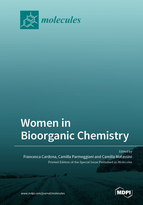Women in Bioorganic Chemistry
A special issue of Molecules (ISSN 1420-3049). This special issue belongs to the section "Bioorganic Chemistry".
Deadline for manuscript submissions: closed (20 February 2022) | Viewed by 52461
Special Issue Editors
Interests: synthetic organic chemistry; carbohydrate-based glycomimetics; glycosidase inhibitors; iminosugar synthesis; lysosomal storage diseases; Gaucher disease; Parkinson disease
Special Issues, Collections and Topics in MDPI journals
Interests: liquid crystalline elastomers; smart materials; biomaterials; artificial muscles; functional cell scaffolds; new synthetic approaches; photoresponsive molecules; photoresponsive materials
Interests: nitrogen-containing glycomimetics; new oxidation methods, hypervalent iodine reagents; multivalency; gold glyconanoparticles; glycosidase inhibitors; lysosomal enzymes; pharmacological chaperones; Gaucher–Parkinson relationship
Special Issues, Collections and Topics in MDPI journals
Special Issue Information
Dear Colleagues,
Recent studies have highlighted that there are still subtle gender biases that put women at a disadvantage when disseminating their research, preventing the science community from benefiting from a wider diversity of voices. In order to embrace gender equality, recognize the career progression of women, and to celebrate the achievements of women in the field of bioorganic chemistry, our journal Molecules will launch a Special Issue on “Women in Bioorganic Chemistry” to be published in 2021.
This Special Issue will include high-quality papers (research articles and short communications) and comprehensive review articles in all areas of bioorganic chemistry. The scope of Special Issue is to cover all range of topics at the organic chemistry-biology interface, including: synthesis of bioactive compounds, biotransformation and enzyme inhibition; enzyme catalysis; nucleic acids chemistry; medicinal chemistry; natural product chemistry, natural product synthesis and biosynthesis; antitumoral, antiviral and antimicrobial agents; carbohydrates, lipid and peptide chemistry; biophysical chemistry; biological probes; bio-orthogonal chemistry and biomimetic chemistry; biotechnology, organic materials for biomedical applications and biomaterials.
Contributions in which women are the corresponding authors of the manuscripts are strongly encouraged.
We look forward to receiving your contributions.
Prof. Dr. Francesca Cardona
Dr. Camilla Parmeggiani
Dr. Camilla Matassini
Guest Editors
Manuscript Submission Information
Manuscripts should be submitted online at www.mdpi.com by registering and logging in to this website. Once you are registered, click here to go to the submission form. Manuscripts can be submitted until the deadline. All submissions that pass pre-check are peer-reviewed. Accepted papers will be published continuously in the journal (as soon as accepted) and will be listed together on the special issue website. Research articles, review articles as well as short communications are invited. For planned papers, a title and short abstract (about 100 words) can be sent to the Editorial Office for announcement on this website.
Submitted manuscripts should not have been published previously, nor be under consideration for publication elsewhere (except conference proceedings papers). All manuscripts are thoroughly refereed through a single-blind peer-review process. A guide for authors and other relevant information for submission of manuscripts is available on the Instructions for Authors page. Molecules is an international peer-reviewed open access semimonthly journal published by MDPI.
Please visit the Instructions for Authors page before submitting a manuscript. The Article Processing Charge (APC) for publication in this open access journal is 2700 CHF (Swiss Francs). Submitted papers should be well formatted and use good English. Authors may use MDPI's English editing service prior to publication or during author revisions.
Keywords
- Bioorganic chemistry
- Synthesis of bioactive compounds
- Natural compounds
- Enzyme inhibition
- Medicinal Chemistry
- Biomaterials









